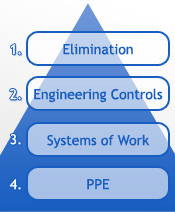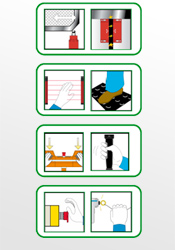Machine Safety
Application Gallery
Employers have obligations under the Health and Safety at Work Act and supporting Health and Safety Regulations (e.g. PUWER) to ensure the work place is, as far as is reasonable practicable, safe from the risk of injury and ill health from potentially hazardous machinery and plant.
Machine operators, maintenance personnel and others should be able to rely on the machine safety system to protect them from injury.
There is an absolute requirement upon organisations to ensure that machinery is designed so that it is safe in normal operation.
Some risks can be avoided by simple measures, but where machine-related hazards cannot be eliminated, through inherently safe design, they must then be reduced to an acceptable level by the use of engineering controls i.e. control the hazards that causes them by the use of guards or other safety devices.

Safety is essential throughout the machine life cycle:
- Design
- Manufacture
- Installation
- Adjustment
- Operation
- Maintenance
- Scrapping
Safety must be taken into account right from the design stage and must be kept in mind at all stages in the life of a machine.


Residual risk is the risk remaining after preventive measures have been taken.
- If you can reduce a risk, no matter how small, you should ALARP (As Low as Reasonably Practicable).
- Total absence of risk is rarely achievable, but it must be reduced to a tolerable level.
- Evaluates risk, identify risk reductions options and then evaluate whether the residual risk is Tolerable.
Heirachy of Control Measures:
- Inherently safe design measures (elimination of the hazard)
- Safeguarding e.g. protective measures realised by safety related control systems
- Complementary protective measures e.g. information for use, training, warning signs
- Personal Protective Equipment

The selection of the most appropriate safety control technology will depend on factors such as:
- The level of risk
- Frequency of access
- Stopping time and access time
- Age of the machine
- Experience of the operator

Directives and Regulations tell you what should be done but provide little information on how to do it.
European and International machinery safety standards have been written to provide machine designers and users with detailed information about basic design concepts, general principles, safety components and devices and detailed safety requirements for specific machine groups.
ISS Safety engineers have a detailed knowledge of these machine safety Directives, Regulations and Standards.
A Full Turnkey Package for Safety and Compliance
With years of experience in the field of machinery safety ISS can provide you with a turn-key service; starting with a comprehensive hazard analysis and risk assessment of the machine or plant, implementing risk reduction by designing the safety control system, installation and commissioning of the safety system, training personnel and full compliance certification.



